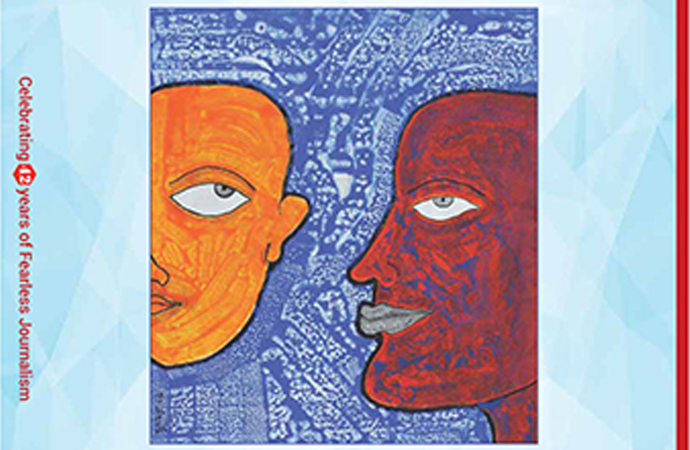Reportage

Kabir Uddin. Photo: Collected
In conversation with Kabir Uddin, a GIS and Remote Sensing Specialist at the International Centre for Integrated Mountain Development (ICIMOD), Nepal.
DC: Firstly, can you tell us about the remotely sensed satellite image?
Kabir Uddin: Remote sensing is the process of collecting data from a distance. It uses sensors on satellites and aircraft that detect reflected or emitted energy to capture and analyze data about Earth's surface and atmosphere, helping geospatial scientists get a great understanding and feel about Earth's present and long-term changes.
DC: Can you tell us about the use of remotely sensed in Bangladesh?
Kabir Uddin: Yes, remote sensing technology as well as GIS (Geographic Information System), has been used in Bangladesh for various purposes to manage, analyze, and visualize geospatial data, enabling better decision-making and land use planning.
As far as I know, Bangladesh Forest Department has been using remote sensing technology for land cover and land use mapping, identification of new afforestation and deforestation areas and national and international reporting. Likewise, the Local Government and Engineering Department (LGED), Roads and Highways Department, Department of Agricultural Extension (DAE), Bangladesh Agricultural Research Council (BARC), Soil Resources Development Institute (SRDI), Bangladesh Space Research and Remote Sensing Organization (SPARRS), Center for Environmental and Geographic Information Services (CEGIS), Institute of Water Modeling (IWM), etc. Many government and private organizations have used geographic information systems for various purposes.
DC: Can you tell potentiality about the use of free remote sensing images in Bangladesh for disaster management and crop mapping?
Kabir Uddin: Yes, there is a massive opportunity for free satellite images in Bangladesh for disaster management, crop mapping, land cover mapping, etc. With free and open satellite data from different sources, including NASA and Copernicus, the European Union's Earth observation programme, it has become easier and more cost-effective to obtain data for these applications in Bangladesh.
Free images are not always used in every area of mapping work in Bangladesh. However, national and international organizations jointly or independently identify and assess the impact of disasters such as flood inundation mapping in Bangladesh using free remote sensing images for disaster management purposes. In addition, satellite imagery is used to identify affected areas, assess crop damage, and plan effective response strategies, including relief operations and evacuations.
DC: Can you give an example of how free remote sensing images can be used in crop mapping in Bangladesh?
Kabir Uddin: Sure, Bangladesh has become one of Asia's most remarkable and unexpected success stories in recent years as the country's economy is triggering rapidly by feeding and utilizing 160 million people. In this process, agriculture is vital in providing food and nutrition security and livelihood opportunities.
In crop mapping, free remote sensing images are the best options to identify and map different crop types and monitor their growth and health over time. In addition, it helps estimate crop yields, identify pest and disease outbreaks, and support precision agriculture practices.
GIS and remote sensing can be used in agriculture for soil mapping and yield forecasting. In addition, it helps farmers make informed decisions about the optimal use of resources, such as water and fertilizers, and identify areas suitable for particular crops.
Even for near real-time harvesting area mapping, Bangladesh takes advantage of the satellite data available in the public domain. It is well known that satellite-based remote sensing techniques can potentially identify large paddy fields that should be harvested immediately. Among the different types of earth observation satellites, freely available RADAR satellite images are most preferred as they can capture images during all-weather in Bangladesh.
DC: How can free remote sensing images be used for other purposes, such as land cover mapping in Bangladesh?
Kabir Uddin: Many researchers use free remote sensing images in land cover mapping in Bangladesh to identify and map different land cover types, such as forests, agricultural land, and urban areas. It helps to monitor land-use changes over time and assess the impact of human activities on the environment. Even free satellites can be used to identify potential marine fishing areas.
In forest cover monitoring, free remote sensing data is more practical to identify and monitor forest cover changes over time. It helps to assess the impact of deforestation and other factors on the forest ecosystem. The data is also used to estimate carbon sequestration potential and to support the implementation of REDD+ (Reducing Emissions from Deforestation and Forest Degradation) programs in the country. In addition, based on the free images, prepared maps can be used for monitoring SDG 15 and other purposes such as Long-Term Strategy (LTS) and Nationally Determined Contribution (NDC).
Also, in most international reporting, such as the National Forest Inventory (NFI), the minimum mapping unit is half a hectare, so we may not always focus on commercial images as free images can meet the requirements.
DC: Are there any challenges to the use of free remote sensing images in Bangladesh?
Kabir Uddin: One of the main challenges is the lack of technical expertise and resources to analyze and interpret remote sensing data. There is a need for more training and capacity-building programs to enhance GIS professionals' skills and end-users' awareness. Nowadays, remote sensing and GIS tasks are mainly applied for project requirements other than routine operational matters.
The critical challenge is that some universities in Bangladesh irregularly offer certificates and master's degrees in remote sensing and GIS, and such degrees sometimes have been discontinued for various reasons. The learning opportunities remain through geography, environmental study, and other university departments offering GIS and remote sensing courses for bachelor's and master's degrees. In addition, foreign-trained or highly educated earth observation professionals are less interested in working in Bangladesh due to fewer facilities and a lack of remote sensing research priority.
Another challenge can be mentioned here in the utilization of satellite imagery. Some remote sensing experts and professionals feel that high-resolution satellite images should be used for environmental management and development purposes. Many believe mapping can be perfected only by buying and using high-resolution commercial images. The general reality is that such assumptions may not be accurate in satellite imagery-based mapping. The accuracy of satellite image-based mapping depends on satellite image analysis skills. It also depends on experience with satellite image analysis software and remote sensing image analysis algorithms. Finally, there is less priority on training and capacity-building programs to enhance the skills of remote sensing professionals and end-users.
DC: Can Bangladesh have any other benefit from free satellite images?
Kabir Uddin: The advantage of free satellite images is that they can be collected at any time without any formality. On the other hand, the particular disadvantage of using high-resolution satellite images is that they are expensive, such as approximately US$15 per square kilometer of the image can be purchased. That is why buying as many images as possible for any given month or year is quite expensive. To purchase any satellite imagery commercially, one has to go through many purchasing procedures, which are time-consuming. Also, since most high-resolution satellites have been launched recently, high-resolution satellite images do not help look at long-term land and vegetation changes in the past, especially since there was no multispectral image archive before 2000. Therefore, free satellite images are the best option to connect space to the village for societal benefits.
DC: Finally, any recommendation for free satellite images in Bangladesh?
Kabir Uddin: I believe various organizations in Bangladesh can use free satellite images for multiple benefits. After all, there is no substitute for additional budget, skilled manpower development and research to scale up and implement any satellite imagery-based work. GIS and remote sensing should be part of the development of smart Bangladesh.
DC: Thank you for your insights on the use of free remote sensing images in Bangladesh.
Kabir Uddin: You're welcome. It was my pleasure to discuss this topic with you.

























Leave a Comment
Recent Posts
The forensic clean up of the f ...
Much of the coverage centring the surge in Non Performing Loans (NPLs) ...
Hong Kong’s deadliest fire in ...
Hong Kong’s deadliest fire in decades left at least 44 people de ...
False document submission hurts genuine students’ ch ..
The Missing Ingredients for Peace in Palestine
Songs of Hyacinth Boats & Hands: Reading Conversatio ..
Executive Editor Julie Pace on why AP is standing fo ..